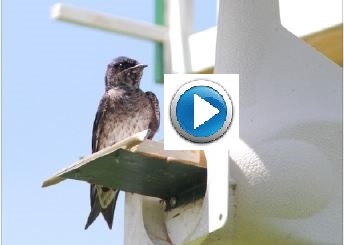Eastern Bluebird Trails
Photo Bertrand Hamel
The Eastern Bluebird is a cavity-nesting bird. With its population at its lowest in the 1970’s, several bird clubs began developing “bluebird trails” throughout North America. The idea is to install several nesting boxes in a favourable habitat. Bluebirds like open areas where they can spot their prey on the ground from a perch and grab it after a short dive.
COBM has been maintaining bluebird trails for decades. Currently, there are three: Vignoble Bromont (Brigham), Vergers Tougas (Dunham) and the Cowansville Golf Club.
Volunteers from COBM visit the nesting boxes from May to September and keep a record of nesting success. The bluebirds are recovering well.
COBM installed two feeding stations in Cowansville several years ago: at Parc naturel Jacques-Bonnette and at Centre de la nature. The latter has been replaced and relocated in 2021. It was inaugurated on February 16, 2022.
Volunteers keep them supplied with seeds throughout the winter. The suet is kindly provided by
Feeding Stations
Photo Hélène Bergeron
Purple Martins
Photo Ghislaine Bacon-Delisle
The Purple Martin is in decline like all swallows. These swallows nest in colonies in dwelling-nesting boxes.
The Club des ornithologues de Brome-Missisquoi installed one in the fall of 2019 in Keith-Sornberger Park in Bedford. It was vandalized but was relocated in the spring of 2021 inside the settling ponds area where an information panel has been set up.
The Chimney Swift is a small bird which, when it arrives in spring, gathers in groups of up to 150 individuals, to spend the night in a chimney that serves as their dormitory. Couples then disperse to nest in a chimney, with one couple per chimney. Researchers are also investigating the possibility of their moving away from urban dormitories to nest in the surrounding woodlands.
The Club des ornithologues de Brome-Missisquoi collaborates with the Canadian Wildlife Service to count Chimney Swifts entering dormitory chimneys in the region, and with the Granby Zoo to identify nesting chimneys. The COBM conducts annual counts for the dormitory chimneys at La Règle de Bedford and École Saint-Léon in Cowansville (having been modified, the latter should be monitored).
The COBM is currently working to locate chimneys occupied either as dormitories or nesting sites, in Farnham, Dunham and Sutton.
Chimney Swifts
Photo Corridor appalachien
Cliff Swallows
Photo Rolande Leblanc
The Cliff Swallow originally nested under cliff ledges, in colonies, and over time has adapted to bridges, viaducts and barns, preferring adherent surfaces such as concrete and rough-textured wood. As well as being victim to the known causes of swallow decline (insect scarcity, habitat loss), the Cliff Swallow is affected by roadworks and renovation work on the structures where it nests. Although not considered endangered, it is a species in constant decline, hence the importance of providing an alternative supply of artificial nests and monitoring colonies. The COBM commissioned a wooden structure containing 10 nesting cells and 12 ceramic nests. The artificial nests will first be installed on the Boul. de l’Aéroport site in Bromont and at Alpagas Sutton farm, with other locations to come. The project is still at an experimental stage.
Collaboration with Granby Zoo’s Conservation and Research team
We have collaborative projects with Granby Zoo’s Conservation en milieu naturel team, which can provide various types of expertise (biologists, veterinarians, construction firms, etc.) and equipment.
eBird surveys of field birds at risk
When identifying status species, we have been suggested an eBird indexing procedure that would facilitate the use of the data. This involves filling in an eBird sheet dedicated to this species, with a precise GPS location. We draw up a 5-minute stationary list. Scientists need our precise data for conservation purposes. To find out more, visit our Scientific Data Collection page.
To know more
To find out how to enter your observations in the eBird database, go to ![]() . To take part in our counting activities, go to
. To take part in our counting activities, go to ![]()
![]()
![]()
Citizen science
Photo Yves Miclette
